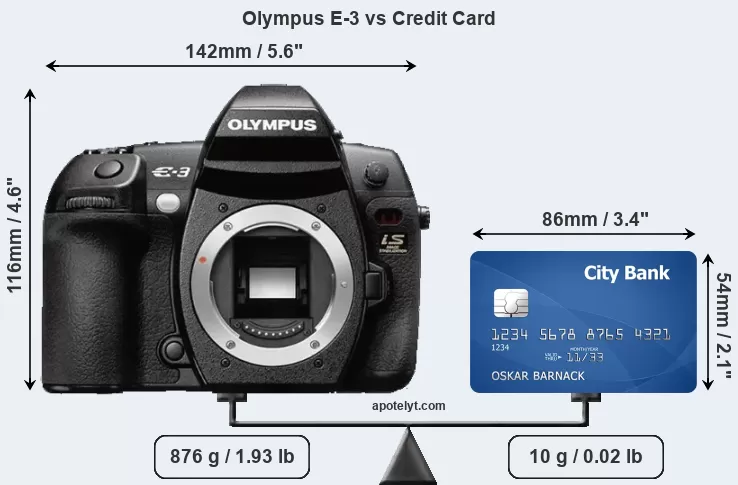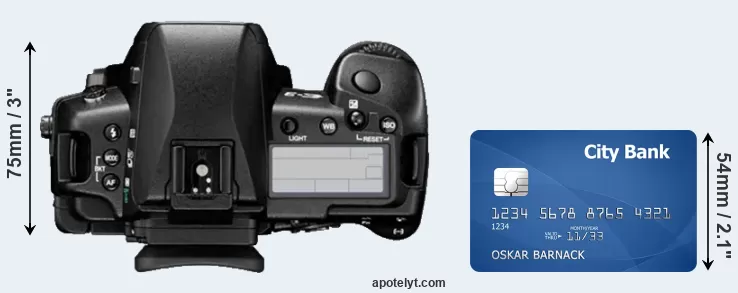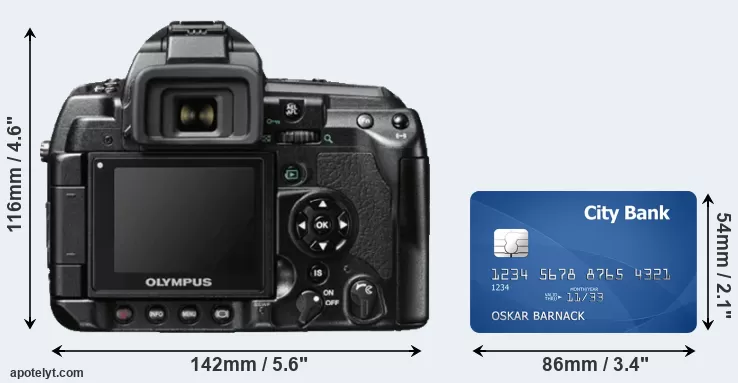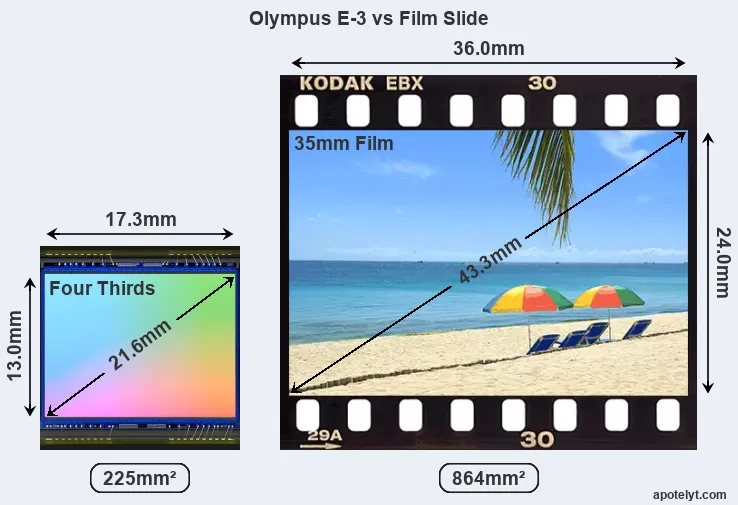Olympus E-3 Comparison Review
The Olympus E-3 is a DSLR (Digital Single Lens Reflex) camera that was officially introduced in October 2007 and is equipped with a Four Thirds sensor. It offers a resolution of 10 megapixel.

Is the Olympus E-3 a good camera? The E-3 has a Camera Elo of 1449. This rating puts the E-3 below average of all digital single lens reflex cameras. In terms of its sensor size category (Four Thirds cameras), the E-3 also ranks below average. Based on its within category standings, the camera earns a 2.5-star performance rating. – Well, the Olympus E-3 is more than 16 years old, and there have been many other good digital cameras released since 2007.
| Olympus E-3 |
|---|
| Digital single lens reflex |
| Four Thirds lenses |
| 10 MP, Four Thirds Sensor |
| no Video |
| ISO 100 - 3 200 |
| Optical viewfinder |
| 2.5 LCD, 230k dots |
| Swivel screen (not touch-sensitive) |
| 5 shutter flaps per second |
| In-body stabilization |
| Weathersealed body |
| 750 shots per battery charge |
| 142 x 116 x 75 mm, 876 g |
Read on to find out more about the camera's size, sensor, features, reception by expert reviewers, and how it compares to other digital cameras.
Body comparison with a credit card
An illustration of the physical dimensions of the Olympus E-3 vis-à-vis a credit card is provided in the side-by-side display below. Three successive views from the front, the top, and the rear are shown. All width, height and depth measures are rounded to the nearest millimeter.



The table below summarizes the key physical specs of the Olympus E-3 alongside a set of similar cameras. If you want to review a particular camera pair side-by-side, just move across to the CAM-parator tool and choose from the broad selection of possible comparisons there.

| Camera Model |
Camera Width |
Camera Height |
Camera Depth |
Camera Weight |
Battery Life |
Weather Sealing |
Camera Launch |
Launch Price (USD) |
Street Price |
||
|---|---|---|---|---|---|---|---|---|---|---|---|
| 1. | Olympus E-3 | 142 mm | 116 mm | 75 mm | 876 g | 750 | Y | Oct 2007 | 1,699 | ebay.com | |
| 2. | Nikon D300 | 147 mm | 114 mm | 74 mm | 925 g | 1000 | Y | Aug 2007 | 1,799 | ebay.com | |
| 3. | Olympus E-1 | 141 mm | 104 mm | 81 mm | 738 g | 750 | Y | Jun 2003 | 1,699 | ebay.com | |
| 4. | Olympus E-5 | 142 mm | 117 mm | 75 mm | 873 g | 750 | Y | Sep 2010 | 1,699 | ebay.com | |
| 5. | Olympus E-30 | 142 mm | 108 mm | 75 mm | 701 g | 750 | n | Nov 2008 | 1,299 | ebay.com | |
| 6. | Olympus E-410 | 130 mm | 91 mm | 53 mm | 435 g | 500 | n | Mar 2007 | 699 | ebay.com | |
| 7. | Olympus E-420 | 130 mm | 91 mm | 53 mm | 440 g | 500 | n | Mar 2008 | 599 | ebay.com | |
| 8. | Olympus E-510 | 136 mm | 92 mm | 68 mm | 538 g | 750 | n | Mar 2007 | 799 | ebay.com | |
| 9. | Olympus E-520 | 136 mm | 92 mm | 68 mm | 535 g | 750 | n | May 2008 | 699 | ebay.com | |
| 10. | Olympus E-600 | 130 mm | 94 mm | 60 mm | 535 g | 500 | n | Aug 2009 | 449 | ebay.com | |
| 11. | Olympus E-620 | 130 mm | 94 mm | 60 mm | 521 g | 500 | n | Feb 2009 | 699 | ebay.com | |
| Note: Measurements and pricing do not include easily detachable parts, such as add-on or interchangeable lenses or optional viewfinders. | |||||||||||
The listed prices provide an indication of the market segment that the manufacturer of the cameras have been targeting. The Olympus E-3 was launched in the US market at a price of $1,699. Usually, retail prices stay at first close to the launch price, but after several months, discounts become available. Later in the product cycle and, in particular, when the replacement model is about to appear, further discounting and stock clearance sales often push the camera price considerably down. Then, after the new model is out, very good deals can frequently be found on the pre-owned market.

Check E-3 offers at
ebay.com
Sensor comparison with a 35mm slide
The size of the sensor inside a digital camera is one of the key determinants of image quality. All other things equal, a large sensor will have larger individual pixel-units that offer better low-light sensitivity, wider dynamic range, and richer color-depth than smaller pixels in a sensor of the same technological generation. Furthermore, a large sensor camera will give the photographer more possibilities to use shallow depth-of-field in order to isolate a subject from the background. On the downside, larger sensors tend to be more expensive and lead to bigger and heavier cameras and lenses.
The Olympus E-3 features a Four Thirds sensor and has a format factor (sometimes also referred to as "crop factor") of 2.0. Within the spectrum of camera sensors, this places the Olympus E-3 among the medium-sized sensor cameras that aim to strike a balance between image quality and portability.

Consistent information on actual sensor performance is available from DXO Mark for most cameras. This service assesses and scores the color depth ("DXO Portrait"), dynamic range ("DXO Landscape"), and low-light sensitivity ("DXO Sports") of camera sensors, and also publishes an overall camera score. The table below summarizes the physical sensor characteristics and sensor quality findings and compares them across a set of similar cameras.

| Camera Model |
Sensor Class |
Resolution (MP) |
Horiz. Pixels |
Vert. Pixels |
Video Format |
DXO Portrait |
DXO Landscape |
DXO Sports |
DXO Overall |
||
|---|---|---|---|---|---|---|---|---|---|---|---|
| 1. | Olympus E-3 | Four Thirds | 10.0 | 3648 | 2736 | none | 21.6 | 10.5 | 571 | 56 | |
| 2. | Nikon D300 | APS-C | 12.2 | 4288 | 2848 | none | 22.1 | 12.0 | 679 | 67 | |
| 3. | Olympus E-1 | Four Thirds | 4.9 | 2560 | 1920 | none | 20.0 | 9.7 | -145 | 44 | |
| 4. | Olympus E-5 | Four Thirds | 12.2 | 4032 | 3024 | 720/30p | 21.6 | 10.5 | 519 | 56 | |
| 5. | Olympus E-30 | Four Thirds | 12.2 | 4032 | 3024 | none | 21.3 | 10.4 | 530 | 55 | |
| 6. | Olympus E-410 | Four Thirds | 10.0 | 3648 | 2736 | none | 21.1 | 10.0 | 494 | 51 | |
| 7. | Olympus E-420 | Four Thirds | 10.0 | 3648 | 2736 | none | 21.5 | 10.4 | 527 | 56 | |
| 8. | Olympus E-510 | Four Thirds | 10.0 | 3648 | 2736 | none | 21.2 | 10.0 | 442 | 52 | |
| 9. | Olympus E-520 | Four Thirds | 10.0 | 3648 | 2736 | none | 21.4 | 10.4 | 548 | 55 | |
| 10. | Olympus E-600 | Four Thirds | 12.2 | 4032 | 3024 | none | 21.5 | 10.3 | 541 | 55 | |
| 11. | Olympus E-620 | Four Thirds | 12.2 | 4032 | 3024 | none | 21.3 | 10.3 | 536 | 55 | |
| Note: DXO values in italics represent estimates based on sensor size and age. | |||||||||||
It should be noted that unlike many modern cameras, the E-3 does not provide the possibility to capture videos.
Feature comparison
Apart from body and sensor, cameras can and do differ across a range of features. For example, the E-3 has an optical viewfinder that provides a field of view of 100% and a magnification of 0.58x. The following tables report on some other key feature differences and similarities of the Olympus E-3 and comparable cameras.

| Camera Model |
Viewfinder (Type or 000 dots) |
Control Panel (yes/no) |
LCD Specifications (inch/000 dots) |
LCD Attach- ment |
Touch Screen (yes/no) |
Max Shutter Speed * |
Max Shutter Flaps * |
Built-in Flash (yes/no) |
Built-in Image Stab |
||
|---|---|---|---|---|---|---|---|---|---|---|---|
| 1. | Olympus E-3 | optical | Y | 2.5 / 230 | swivel | n | 1/8000s | 5.0/s | Y | Y | |
| 2. | Nikon D300 | optical | Y | 3.0 / 922 | fixed | n | 1/8000s | 6.0/s | Y | n | |
| 3. | Olympus E-1 | optical | Y | 1.8 / 134 | fixed | n | 1/4000s | 3.0/s | n | n | |
| 4. | Olympus E-5 | optical | Y | 3.0 / 920 | swivel | n | 1/8000s | 5.0/s | Y | Y | |
| 5. | Olympus E-30 | optical | Y | 2.7 / 230 | swivel | n | 1/8000s | 5.0/s | Y | Y | |
| 6. | Olympus E-410 | optical | n | 2.5 / 215 | fixed | n | 1/4000s | 3.0/s | Y | n | |
| 7. | Olympus E-420 | optical | n | 2.7 / 215 | fixed | n | 1/4000s | 3.5/s | Y | n | |
| 8. | Olympus E-510 | optical | n | 2.5 / 215 | fixed | n | 1/4000s | 3.0/s | Y | Y | |
| 9. | Olympus E-520 | optical | n | 2.7 / 215 | fixed | n | 1/4000s | 3.5/s | Y | Y | |
| 10. | Olympus E-600 | optical | n | 2.7 / 230 | swivel | n | 1/4000s | 4.0/s | Y | Y | |
| 11. | Olympus E-620 | optical | n | 2.7 / 230 | swivel | n | 1/4000s | 4.0/s | Y | Y | |
| Note: *) Information refers to the mechanical shutter, unless the camera only has an electronic one. | |||||||||||
The LCD screen on the Olympus E-3 is flexibly attached to the body. In particular, the LCD is hinged on the side and can be flipped out for odd-angle shots in both portrait and landscape orientation. Also, this fully articulated, swivel type of LCD attachment is often appreciated by videographers for its flexibility. Moreover, v-loggers like the design because the screen can be turned to be front-facing.

One convenient feature of the E-3 is the presence of an on-board flash. While this built-in flash is not very powerful, it can at times be useful as a fill-in light to brighten deep shadow areas.
Connection comparison
For some imaging applications, the extent to which a camera can communicate with its environment can be an important aspect in the camera decision process. The table below provides an overview of the connectivity of the Olympus E-3 and, in particular, the interfaces the cameras (and selected comparators) provide for accessory control and data transfer.

| Camera Model |
Hotshoe Port |
Internal Mic / Speaker |
Microphone Port |
Headphone Port |
HDMI Port |
USB Port |
WiFi Support |
NFC Support |
Bluetooth Support |
||
|---|---|---|---|---|---|---|---|---|---|---|---|
| 1. | Olympus E-3 | Y | - / - | - | - | - | 2.0 | - | - | - | |
| 2. | Nikon D300 | Y | - / - | - | - | mini | 2.0 | - | - | - | |
| 3. | Olympus E-1 | Y | - / - | - | - | - | 2.0 | - | - | - | |
| 4. | Olympus E-5 | Y | stereo / - | - | - | mini | 2.0 | - | - | - | |
| 5. | Olympus E-30 | Y | - / - | - | - | - | 2.0 | - | - | - | |
| 6. | Olympus E-410 | Y | - / - | - | - | - | 2.0 | - | - | - | |
| 7. | Olympus E-420 | Y | - / - | - | - | - | 2.0 | - | - | - | |
| 8. | Olympus E-510 | Y | - / - | - | - | - | 2.0 | - | - | - | |
| 9. | Olympus E-520 | Y | - / - | - | - | - | 2.0 | - | - | - | |
| 10. | Olympus E-600 | Y | - / - | - | - | - | 2.0 | - | - | - | |
| 11. | Olympus E-620 | Y | - / - | - | - | - | 2.0 | - | - | - |
Further information on the features and operation of the E-3 can be found in the free online Olympus E-3 Manual or on the Olympus support site.
Expert reviews
While the specs-based evaluation of cameras is instructive in revealing their potential as photographic tools, it remains incomplete and does no justice, for example, to the way the E-3 handle or perform in practice. User reviews that are available, for instance, at amazon can sometimes shed light on these issues, but such feedback is all too often partial, inconsistent, and inaccurate. This is where reviews by experts come in. The table below summarizes the assessments of some of the best known camera review sites (amateurphotographer [AP], cameralabs [CL], digitalcameraworld [DCW], dpreview [DPR], ephotozine [EPZ], photographyblog [PB]).

| Camera Model |
AP score |
CL score |
DCW score |
DPR score |
EPZ score |
PB score |
Camera Launch |
Launch Price (USD) |
Street Price |
||
|---|---|---|---|---|---|---|---|---|---|---|---|
| 1. | Olympus E-3 | .. | 88/100 | .. | + + | o | 4/5 | Oct 2007 | 1,699 | ebay.com | |
| 2. | Nikon D300 | .. | + + | .. | + + | 5/5 | 4.5/5 | Aug 2007 | 1,799 | ebay.com | |
| 3. | Olympus E-1 | .. | .. | .. | + | o | .. | Jun 2003 | 1,699 | ebay.com | |
| 4. | Olympus E-5 | 4/5 | .. | .. | 75/100 | 4/5 | 4.5/5 | Sep 2010 | 1,699 | ebay.com | |
| 5. | Olympus E-30 | .. | .. | .. | 71/100 | 4.5/5 | 4/5 | Nov 2008 | 1,299 | ebay.com | |
| 6. | Olympus E-410 | .. | 86/100 | .. | + + | 4/5 | 4.5/5 | Mar 2007 | 699 | ebay.com | |
| 7. | Olympus E-420 | .. | 85/100 | .. | + + | 4/5 | 4.5/5 | Mar 2008 | 599 | ebay.com | |
| 8. | Olympus E-510 | .. | 89/100 | .. | + + | 3.5/5 | 4.5/5 | Mar 2007 | 799 | ebay.com | |
| 9. | Olympus E-520 | .. | 87/100 | .. | + + | 4.5/5 | 4.5/5 | May 2008 | 699 | ebay.com | |
| 10. | Olympus E-600 | .. | .. | .. | .. | .. | 4.5/5 | Aug 2009 | 449 | ebay.com | |
| 11. | Olympus E-620 | 3/5 | 88/100 | .. | 72/100 | 4.5/5 | 5/5 | Feb 2009 | 699 | ebay.com | |
| Note: (+ +) highly recommended; (+) recommended; (o) reviewed; (..) not available. | |||||||||||
The above review scores should be interpreted with care, though. The ratings were established in reference to similarly priced cameras that were available in the market at the time of the review. Hence, a score should always be seen in the context of the camera's market launch date and its price, and rating-comparisons among cameras that span long time periods or concern very differently equipped models make little sense. Also, kindly note that some of the listed sites have over time developped their review approaches and their reporting style.

Check E-3 offers at
ebay.com
Olympus E-3 FAQ
Below are some additional questions and answers concerning some particular features of the E-3.
What technology is the imaging sensor in the Olympus E-3 based on?
The camera has a CMOS (Complementary Metal–Oxide–Semiconductor) sensor at its core.
Which image processing chip is used in the Olympus E-3 to convert the raw signal into an image file and perform noise reduction and image sharpening?
Olympus equipped the E-3 with the TruePic III image processor.
What is the ISO sensitivity range of the Olympus E-3?
The camera has a native sensitivity range from ISO 100 to ISO 3200.
Does the Olympus E-3 have a selfie-friendly screen?
Yes, the LCD-screen of the E-3 is flexible and can be turned to be front-facing for capturing selfies.
What is the life expectancy of the shutter in the Olympus E-3?
Olympus mentions a shutter rating of 150 000 actuations for the E-3. This number represents a Mean Time before Failure, that is an average value. The shutter might fail earlier, or it might last longer. Anyway, in order to exhaust the expected shutter life of the E-3 over, say, three years, one would have to take about 150 pictures each and every day.
How do I find the shutter count on my Olympus E-3?
Olympus embeds the number of shutter actuations in hidden menus. You can check the number of shots that your E-3 has taken up to now by carefully following the steps described on the Olympus E-3 shutter count page.
Does the Olympus E-3 feature an autofocus assist light?
Yes, the camera has a lamp built-in that can illuminate the subject and improve autofocus in low-light settings.
What is the fastest shutter speed that can be used with the Olympus E-3 for flash photography?
The E-3's flash sync speed is 1/250 sec.
Which battery does the Olympus E-3 use?
The camera gets its power from the Olympus BLM-1 (here at amazon), which is a rechargeable Lithium-Ion power pack.
Is there a vertical grip available for the Olympus E-3?
Yes, Olympus offers the HLD-4 as an optional accessory to facilitate shooting in portrait orientation and to provide additional battery power.
Camera to camera comparisons
In case you would like to check on the differences and similarities with other camera models, just use the search menu below. Alternatively, you can follow any of the listed hyperlinks for comparisons that others found interesting.
- Canon 80D vs Olympus E-3
- Canon G3 X vs Olympus E-3
- Canon G5 X Mark II vs Olympus E-3
- Fujifilm X-H1 vs Olympus E-3
- Leica Q2 vs Olympus E-3
- Nikon B700 vs Olympus E-3
- Nikon D1 vs Olympus E-3
- Nikon D850 vs Olympus E-3
- Nikon P7800 vs Olympus E-3
- Olympus E-3 vs Olympus E-410
- Olympus E-3 vs Pentax K-70
- Olympus E-3 vs Sony RX0 II
| Camera Model | Olympus E-3 | |
|---|---|---|
| Camera Type | Digital single lens reflex | |
| Camera Lens | Four Thirds lenses | |
| Launch Date | October 2007 | |
| Launch Price | USD 1 699 | |
| Sensor Specs | ||
| Sensor Technology | CMOS | |
| Sensor Format | Four Thirds Sensor | |
| Sensor Size | 17.3 x 13.0 mm | |
| Sensor Area | 225 mm2 | |
| Sensor Diagonal | 21.6 mm | |
| Crop Factor | 2.0x | |
| Sensor Resolution | 10 Megapixels | |
| Image Resolution | 3 648 x 2 736 pixels | |
| Pixel Pitch | 4.74 μm | |
| Pixel Density | 4.44 MP/cm2 | |
| Moiré control | Anti-Alias filter | |
| Movie Capability | no Video | |
| ISO Setting | 100 - 3 200 ISO | |
| Image Processor | TruePic III | |
| DXO Sensor Quality (score) | 56 | |
| DXO Color Depth (bits) | 21.6 | |
| DXO Dynamic Range (EV) | 10.5 | |
| DXO Low Light (ISO) | 571 | |
| Screen Specs | ||
| Viewfinder Type | Optical viewfinder | |
| Viewfinder Field of View | 100% | |
| Viewfinder Magnification | 0.58x | |
| Top-Level Screen | Control Panel | |
| LCD Framing | Live View | |
| LCD Size | 2.5 inch | |
| LCD Resolution | 230k dots | |
| LCD Attachment | Swivel screen | |
| V-logging Friendliness | Front-flip possible | |
| Touch Input | No touchscreen | |
| Shooting Specs | ||
| Focus System | Phase-detect AF | |
| Manual Focusing Aid | no Peaking Feature | |
| Maximum Shutter Speed | 1/8000s | |
| Continuous Shooting | 5 shutter flaps/s | |
| Shutter Life Expectancy | 150 000 actuations | |
| Silent Shooting | no E-Shutter | |
| Time Lapse Photography | no Intervalometer | |
| Image Stabilization | In-body stabilization | |
| Fill Flash | Built-in Flash | |
| Storage Medium | CF or XD cards | |
| Single or Dual Card Slots | Dual card slots | |
| Connectivity Specs | ||
| External Flash | Hotshoe | |
| Studio Flash | PC Sync socket | |
| USB Connector | USB 2.0 | |
| HDMI Port | no HDMI | |
| Wifi Support | no Wifi | |
| Body Specs | ||
| Environmental Sealing | Weathersealed body | |
| Battery Type | Olympus BLM-1 power pack | |
| Battery Life (CIPA) | 750 shots per charge | |
| Body Dimensions |
142 x 116 x 75 mm (5.6 x 4.6 x 3.0 in) |
|
| Camera Weight | 876 g (30.9 oz) | |
Did you notice an error on this page? If so, please get in touch, so that we can correct the information.
You are here: Home » CAM-parator » Olympus E-3 Review
